Architecture and stability of the second–order cellular neural networks
In this paper, we study and propose i) Second-order Cellular Neural Networks (SOCNN) architecture
based on standard CNN proposed by Leon. O. Chua with the 2nd-order polynomial inputs and bounded
parameter assumptions. ii) The conditions for the existence and stability of the solutions of CNN are
presented by choosing appropriate Lyapunov function. iii) Simulation and computing results by the simple
example are perfomed on the Matlab (2014) Simulink.
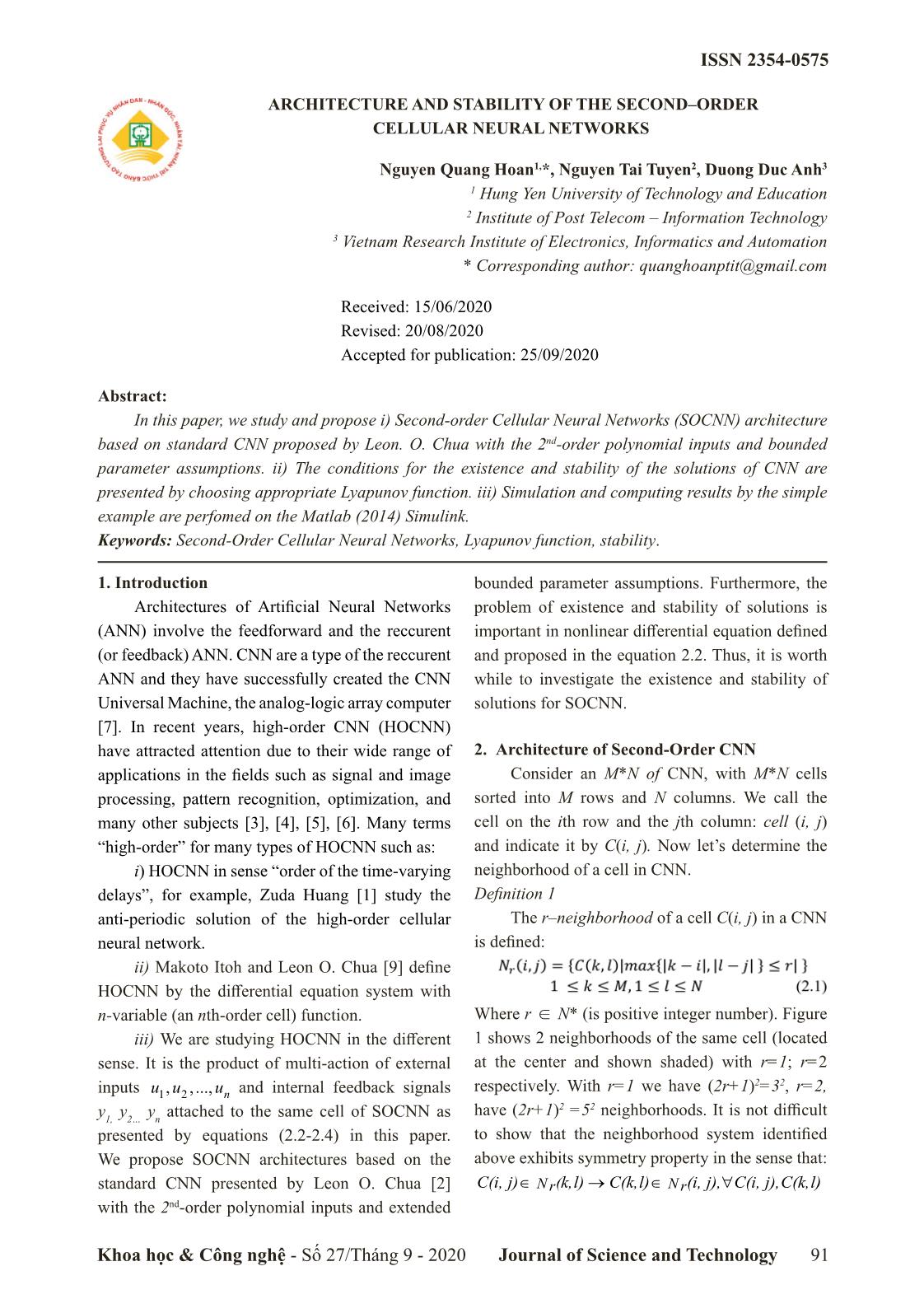
Trang 1
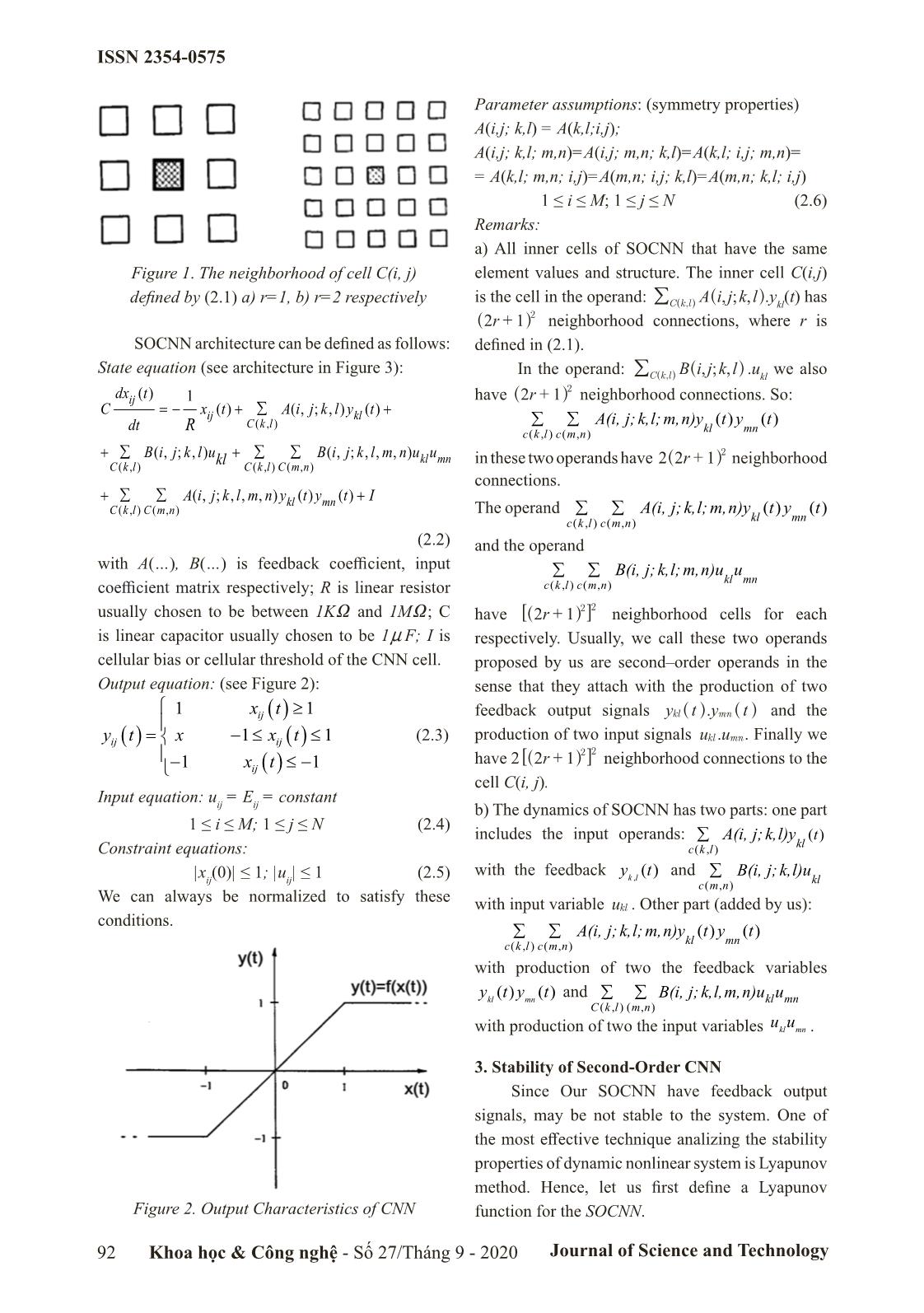
Trang 2
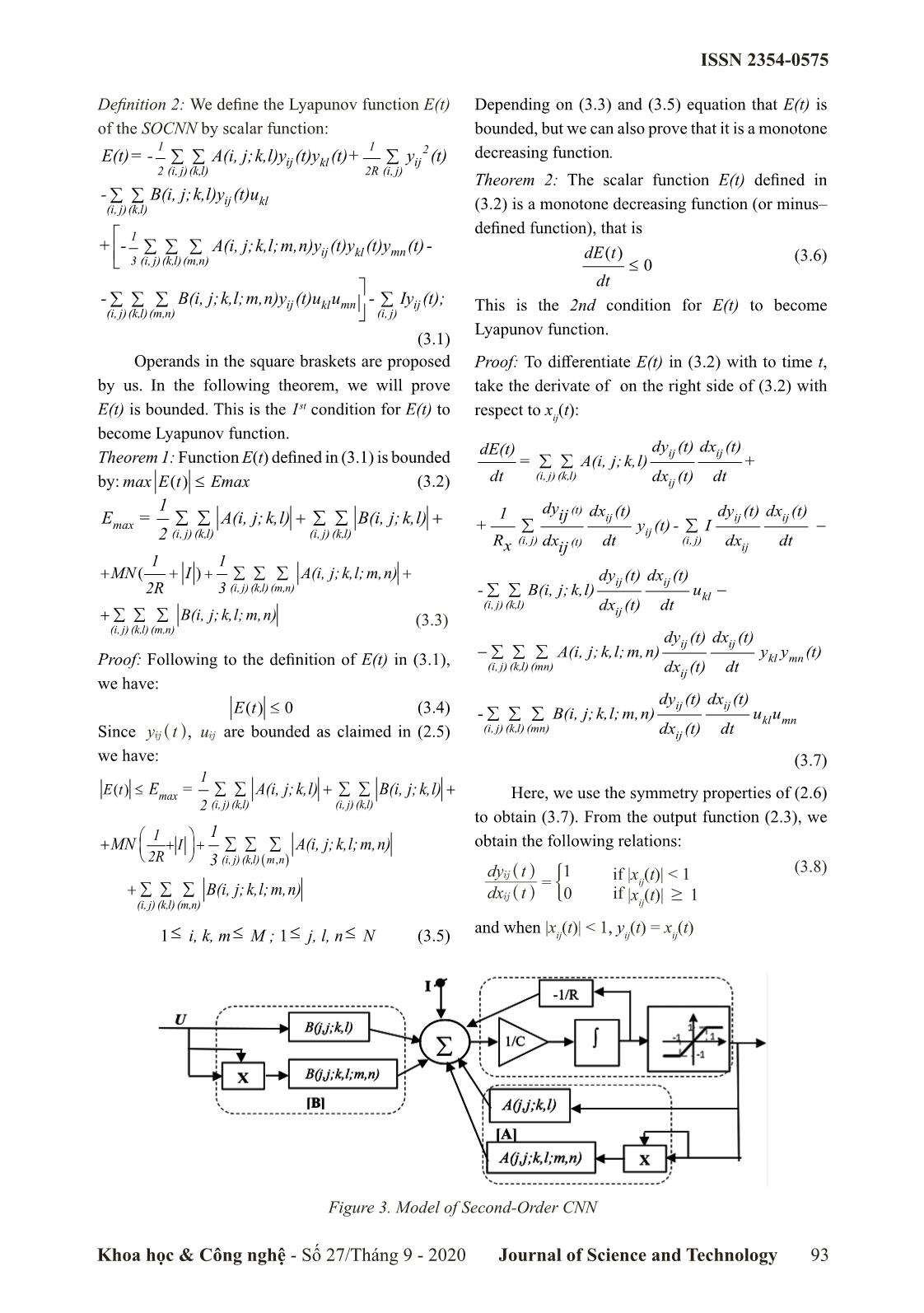
Trang 3
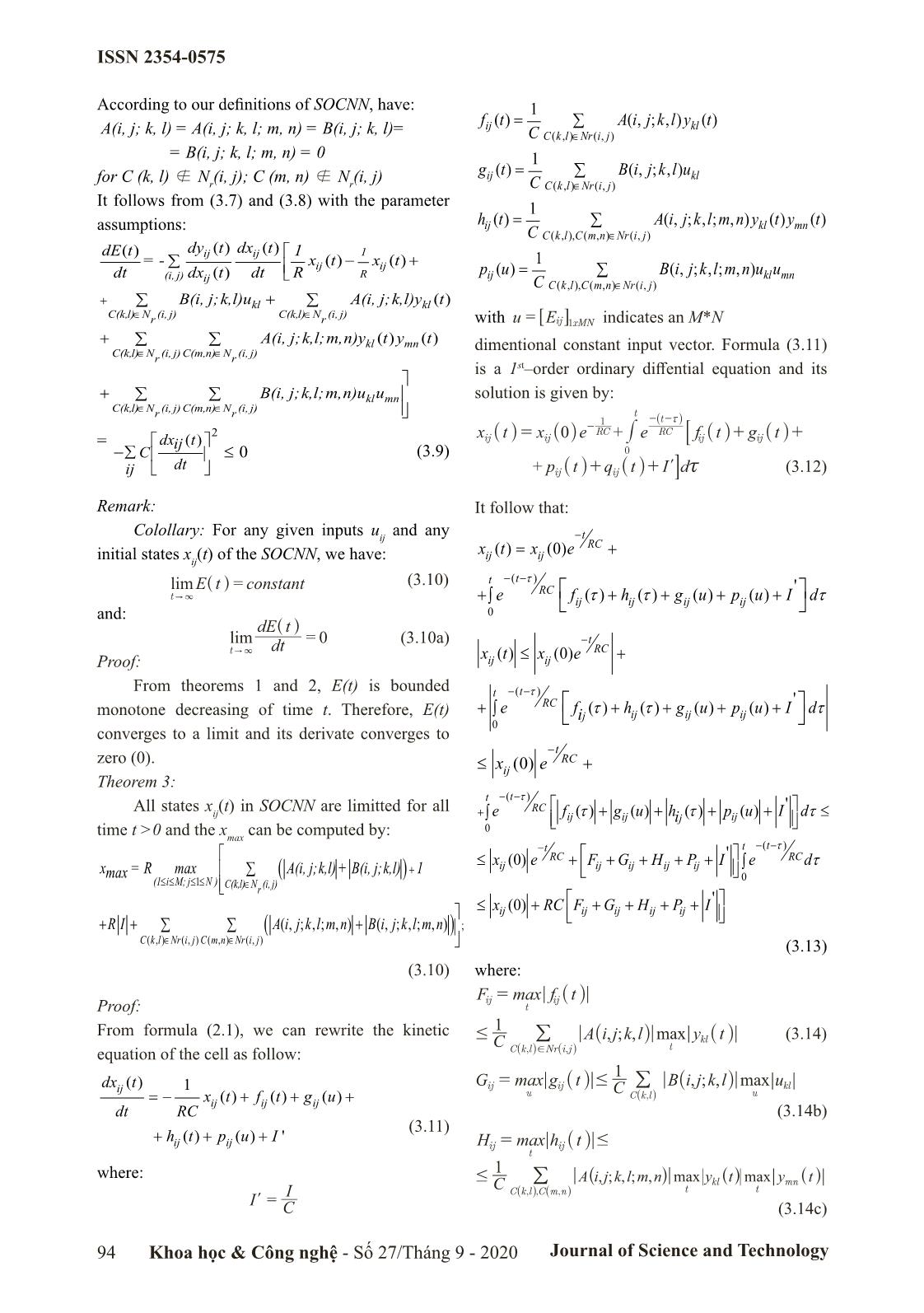
Trang 4
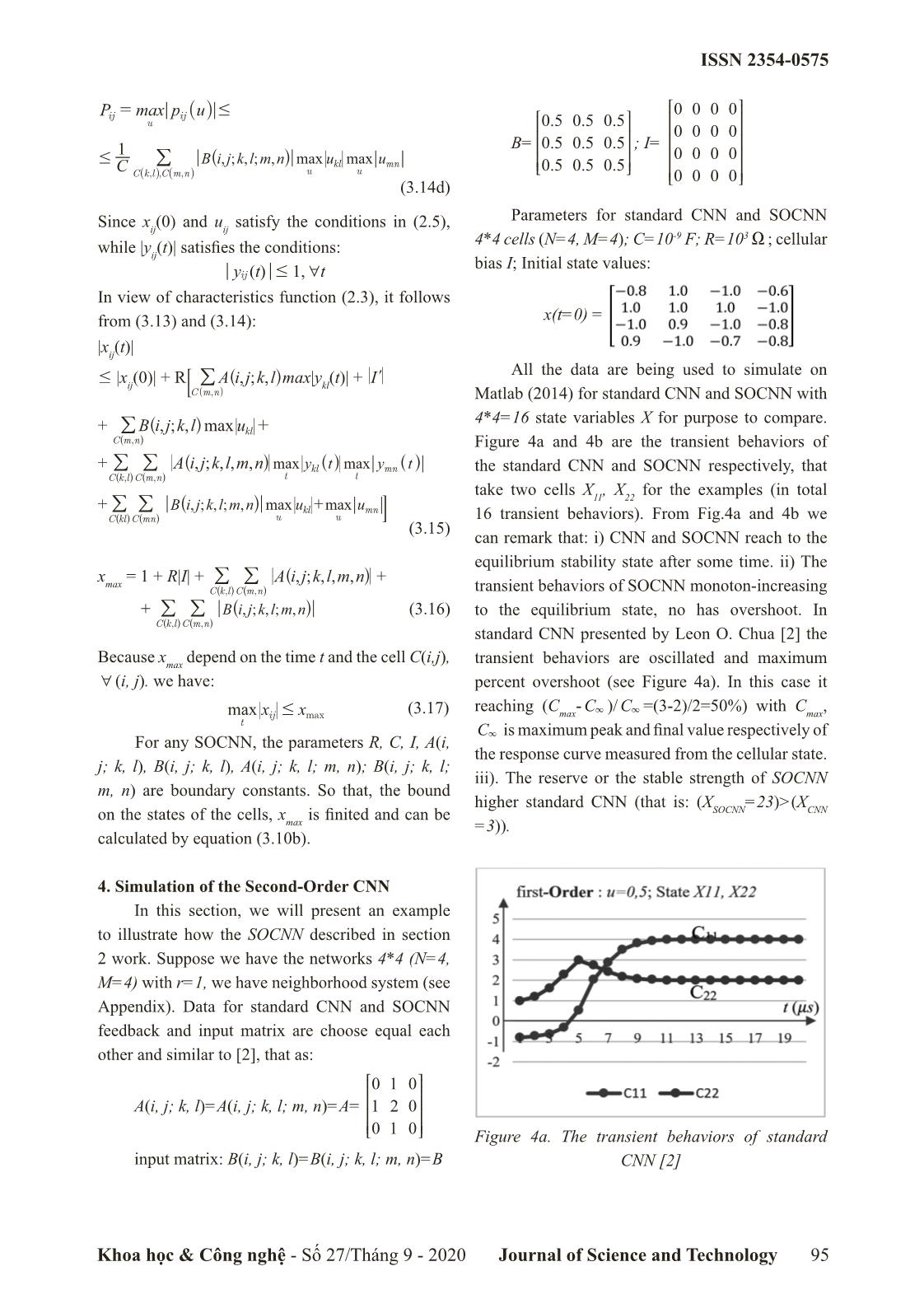
Trang 5
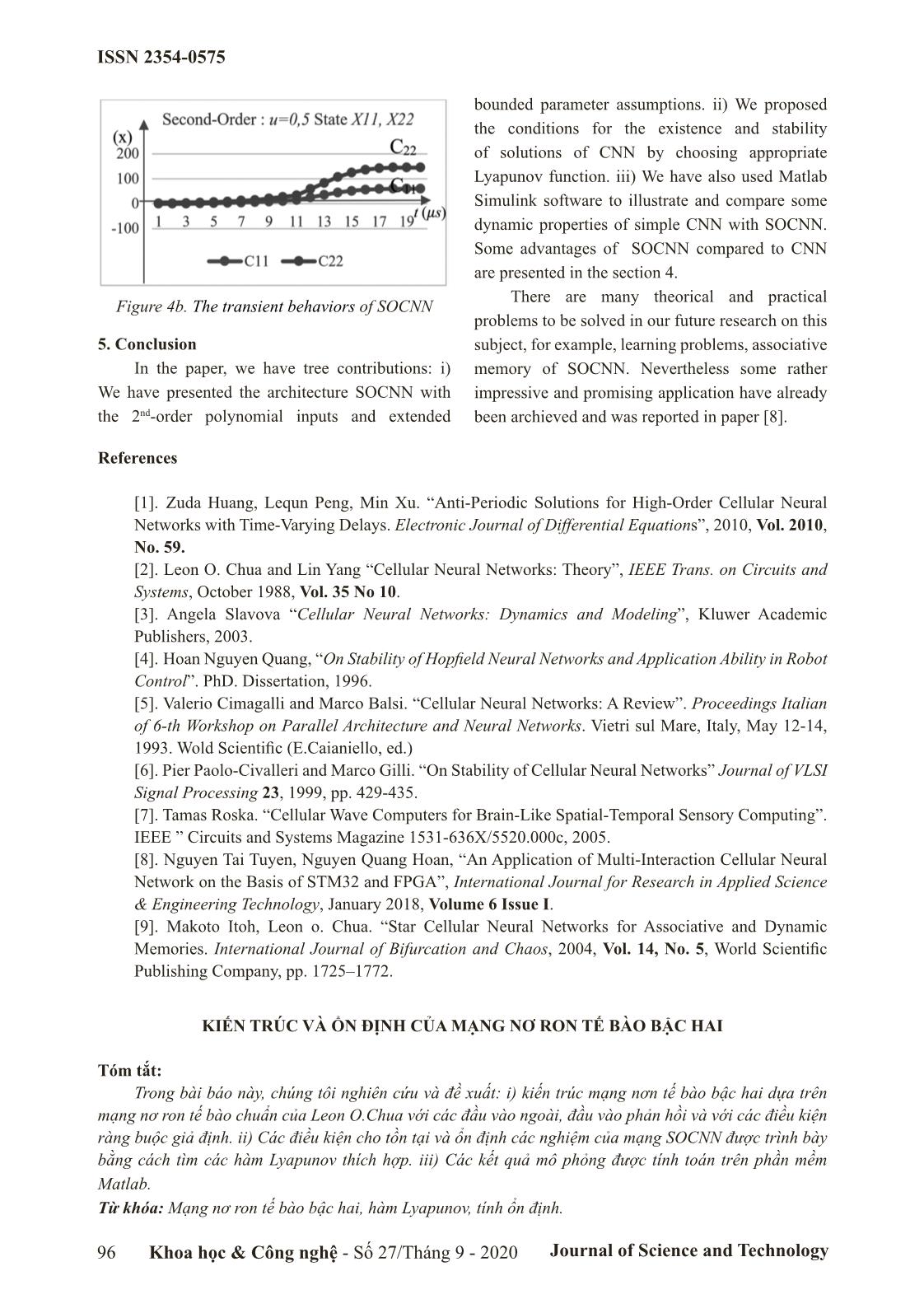
Trang 6
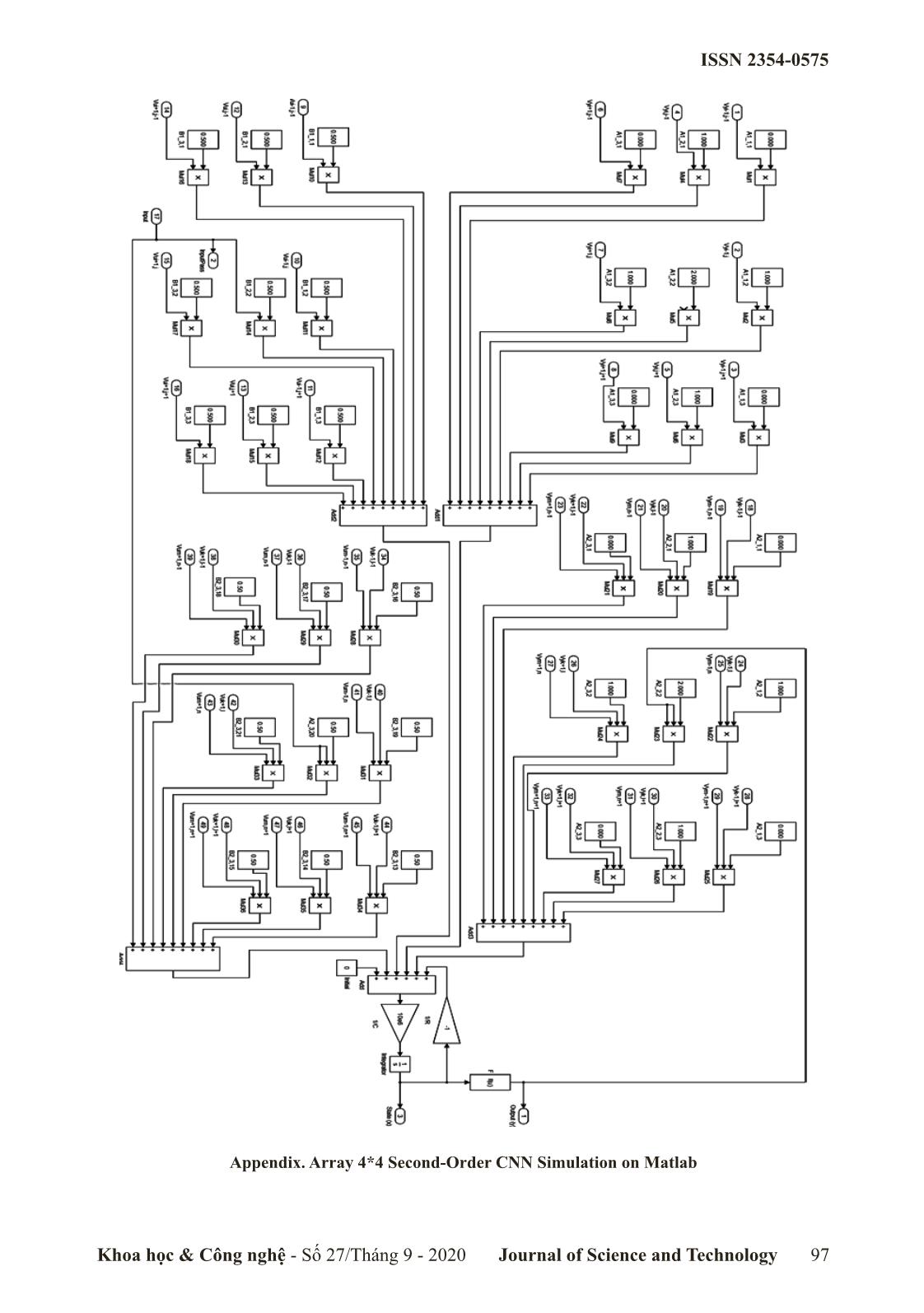
Trang 7
Bạn đang xem tài liệu "Architecture and stability of the second–order cellular neural networks", để tải tài liệu gốc về máy hãy click vào nút Download ở trên
Tóm tắt nội dung tài liệu: Architecture and stability of the second–order cellular neural networks
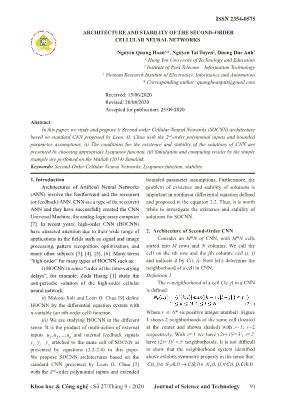
with the 2nd-order polynomial inputs and extended Khoa học & Công nghệ - Số 27/Tháng 9 - 2020 Journal of Science and Technology 91 ISSN 2354-0575 Parameter assumptions: (symmetry properties) A(i,j; k,l) = A(k,l;i,j); A(i,j; k,l; m,n)=A(i,j; m,n; k,l)=A(k,l; i,j; m,n)= = A(k,l; m,n; i,j)=A(m,n; i,j; k,l)=A(m,n; k,l; i,j) 1 ≤ i ≤ M; 1 ≤ j ≤ N (2.6) Remarks: a) All inner cells of SOCNN that have the same Figure 1. The neighborhood of cell C(i, j) element values and structure. The inner cell C(i,j) ,; , defined by(2.1) a) r=1, b) r=2 respectively is the cell in the operand: /Ck,l Aijkl .ykl(t) has ^ h ^ h 21r + 2 neighborhood connections, where r is ^h SOCNN architecture can be defined as follows: defined in (2.1). ,; , State equation (see architecture in Figure 3): In the operand: /Ck,l Bijkl .ukl we also ^ h ^ h 21+ 2 dxij () t 1 have r neighborhood connections. So: C =−+x() t∑ Ai (, j ; k , l ) y () t + ^h ij kl ∑∑A(i, j;k,l;m,n)y() t y () t dt C( kl ,) kl mn R ckl( ,) cmn ( , ) ++∑ ∑∑ 2 Bi(, jklu ; , ) kl Bi(, jklmnu ; , , , ) kl u mn in these two operands have 22r + 1 neighborhood Ckl( ,) CklCmn( ,) ( , ) ^h connections. ++∑∑Ai(, j ; k ,, l mn , ) ykl () t y mn () t I CklCmn( ,) ( , ) The operand ∑∑A(i, j;k,l;m,n)y() t y () t kl mn ckl( ,) cmn ( , ) (2.2) and the operand with A(), B() is feedback coefficient, input ∑∑B(i, j;k,l;m,n)u u kl mn coefficient matrix respectively; R is linear resistor ckl( ,) cmn ( , ) 2 usually chosen to be between 1KX and 1MX; C have 21r + 2 neighborhood cells for each 6@^h is linear capacitor usually chosen to be 1n F; I is respectively. Usually, we call these two operands cellular bias or cellular threshold of the CNN cell. proposed by us are second–order operands in the Output equation: (see Figure 2): sense that they attach with the production of two 11xt( ) ≥ feedback output signals ytkl .ytmn and the ij ^^hh ytij ( ) = x −≤11 xtij ( ) ≤ (2.3) production of two input signals uukl . mn. Finally we 2 2 − ≤− have 2 21r + neighborhood connections to the 11xtij ( ) 6@^h cell C(i, j). Input equation: u = E = constant ij ij b) The dynamics of SOCNN has two parts: one part 1 ≤ i ≤ M; 1 ≤ j ≤ N (2.4) includes the input operands: ∑ A(i, j;k,l)y ()t kl Constraint equations: ckl( ,) with the feedback yt() and ∑ B(i, j;k,l)u |xij(0)| ≤ 1; |uij| ≤ 1 (2.5) kl, kl c( mn ,) We can always be normalized to satisfy these with input variable ukl . Other part (added by us): conditions. ∑∑A(i, j;k,l;m,n)y() t y () t kl mn ckl( ,) cmn ( , ) with production of two the feedback variables ykl() ty mn () t and ∑∑B(i, j;k,l,m,n)ukl u mn C( kl , )( mn , ) with production of two the input variables uukl mn . 3. Stability of Second-Order CNN Since Our SOCNN have feedback output signals, may be not stable to the system. One of the most effective technique analizing the stability properties of dynamic nonlinear system is Lyapunov method. Hence, let us first define a Lyapunov Figure 2. Output Characteristics of CNN function for the SOCNN. 92 Khoa học & Công nghệ - Số 27/Tháng 9 - 2020 Journal of Science and Technology ISSN 2354-0575 Definition 2: We define the Lyapunov function E(t) Depending on (3.3) and (3.5) equation that E(t) is of the SOCNN by scalar function: bounded, but we can also prove that it is a monotone 112 decreasing function. E(t)= -∑∑ A(i, j;k,l)yij (t)ykl (t)+∑ yij (t) 2 (i, j)(k,l) 2R (i, j) Theorem 2: The scalar function E(t) defined in -∑∑ B(i, j;k,l)yij (t)ukl (i, j)(k,l) (3.2) is a monotone decreasing function (or minus– 1 defined function), that is + -∑∑ ∑ A(i, j;k,l;m,n)y (t)y (t)y (t)- ij kl mn dE() t (3.6) 3 (i, j)(k,l)(m,n) ≤ 0 dt -∑∑ ∑ B(i, j;k,l;m,n)yij (t)ukl u mn -∑ Iyij (t); This is the 2nd condition for E(t) to become (i, j)(k,l)(m,n) (i, j) Lyapunov function. (3.1) Operands in the square braskets are proposed Proof: To differentiate E(t) in (3.2) with to time t, by us. In the following theorem, we will prove take the derivate of on the right side of (3.2) with st E(t) is bounded. This is the 1 condition for E(t) to respect to xij(t): become Lyapunov function. dE(t) dyij (t) dx ij (t) Theorem 1: Function E(t) defined in (3.1) is bounded =∑∑ A(i, j;k,l) + (i, j) (k,l) by: max E() t≤ Emax (3.2) dt dxij (t) dt 1 dy (t) ++1 ij dxij (t) dyij (t) dx ij (t) Emax =∑∑ A(i, j;k,l)∑∑ B(i, j;k,l) ∑∑− (i, j) (k,l) (i, j) (k,l) + y(t)ij - I 2 (i, j) (i, j) Rx dxij (t) dt dxij dt 11 ++MN() I + ∑∑ ∑ A(i, j;k,l;m,n) + dyij (t) dx ij (t) (i, j) (k,l) (m,n) 2R 3 -∑∑ B(i, j;k,l) ukl − (i, j) (k,l) dxij (t) dt + ∑∑ ∑ B(i, j;k,l;m,n) (3.3) (i, j) (k,l) (m,n) dyij(t) dx ij (t) − ∑∑∑ A(i, j;k,l;m,n) ykl y mn (t) Proof: Following to the definition of E(t) in (3.1), (i, j) (k,l) (mn) dxij (t) dt we have: dy (t) dx (t) Et()≤ 0 (3.4) ij ij -∑∑∑ B(i, j;k,l;m,n) ukl u mn (i, j) (k,l) (mn) Since ytij , uij are bounded as claimed in (2.5) dxij (t) dt ^h we have: (3.7) 1 Et()≤ Emax =∑∑ A(i, j;k,l)++∑∑ B(i, j;k,l) Here, we use the symmetry properties of (2.6) 2 (i, j) (k,l) (i, j) (k,l) to obtain (3.7). From the output function (2.3), we 1 1 +MN ++I ∑∑ ∑ A(i, j;k,l;m,n) obtain the following relations: 2R (i, j) (k,l)( m, n) 3 1 (3.8) dyij t = if |x (t)| < 1 + ^ h ij ∑∑ ∑ B(i, j;k,l;m,n) dxij t (0 if |x (t)| $ 1 (i, j) (k,l) (m,n) ^ h ij and when |x (t)| < 1, y (t) = x (t) 1 ≤ i, k, m ≤ M ; 1 ≤ j, l, n ≤ N (3.5) ij ij ij Figure 3. Model of Second-Order CNN Khoa học & Công nghệ - Số 27/Tháng 9 - 2020 Journal of Science and Technology 93 ISSN 2354-0575 According to our definitions ofSOCNN , have: 1 fij () t = ∑ Ai(, jkl ; ,) ykl () t A(i, j; k, l) = A(i, j; k, l; m, n) = B(i, j; k, l)= C C( k ,) l∈ Nr (, i j ) = B(i, j; k, l; m, n) = 0 1 = for C (k, l) g N (i, j); C (m, n) g N (i, j) gij () t ∑ Bi(, jklu ; , ) kl r r C C( k ,) l∈ Nr (, i j ) It follows from (3.7) and (3.8) with the parameter 1 assumptions: hij () t = ∑ Ai(, jklmn ; ,; , ) ykl () t y mn () t C Ckl( , ), Cmn ( , )∈ Nrij ( , ) dE() t dyij() t dx ij () t 1 1 ∑ −+ 1 =- xtij() xt ij () = ∑ dt(i, j) dxij () t dt R R pij () u Bi(, jklmnu ; ,; , ) kl u mn C Ckl( , ), Cmn ( , )∈ Nrij ( , ) + ∑∑B(i, j;k,l)ukl + A(i, j;k,l)ykl () t C(k,l)∈∈ N (i, j) C(k,l) N (i, j) rrwith uE= ij indicates an M*N 6@1xMN + ∑∑A(i, j;k,l;m,n)ykl() t y mn () t ∈∈ dimentional constant input vector. Formula (3.11) C(k,l) Nrr (i, j) C(m,n) N (i, j) is a 1st–order ordinary diffential equation and its + ∑∑B(i, j;k,l;m,n)ukl u mn solution is given by: ∈ ∈ C(k,l) Nr (i, j) C(m,n) Nr (i, j) t 1 --t x - RC _iRC 2 xtij = xij 0 e + # e ftij + gtij + = dxij () t __ii 8 _i _i −≤∑ C0 (3.9) (3.9) 0 ij dt + ptij + qtij + Idl x (3.12) _i _i B Remark: It follow that: Colollary: For any given inputs uij and any −t RC xtij( )= x ij (0) e + initial states xij(t) of the SOCNN, we have: lim = (3.10) t −−()t τ Et constant RC ' t " 3 ^h +e f()ττ ++ h () gu () + pu () + I dτ ∫ ij ij ij ij and: 0 dE t lim ^h= 0 (3.10a) −t t " 3 dt xt( )≤+ x (0) eRC Proof: ij ij From theorems 1 and 2, E(t) is bounded −−τ t ()t ' +eRC f()ττ++ h () gu () + pu () + I dτ monotone decreasing of time t. Therefore, E(t) ∫ ij ij ij ij 0 converges to a limit and its derivate converges to −t zero (0). RC ≤+xeij (0) Theorem 3: t −−()t τ RC ' All states xij(t) in SOCNN are limitted for all + e f()ττ+++ gu () h () pu () + I d τ ≤ ∫ ij ij ij ij 0 time t >0 and the xmax can be computed by: −t t −−()t τ ≤x(0) eRC + FGH + + ++ P I' eRC dτ ∑ + ij ij ij ij ij ∫ xmax = R max ( A(i, j;k,l) + B(i, j;k,l)) 1 0 (1≤≤ i M; j ≤≤1 N ) ∈ C(k,l) Nr (i, j) ≤x(0) + RC F + G + H ++ P I' ij ij ij ij ij ++RI ∑∑( Ai(, jklmn ; ,; , )+ Bi (, jklmn ; ,; , )) ; C( k ,) l∈∈ Nr (, i j ) C ( m , n ) Nr (, i j ) (3.13) (3.10) where: Ffij = max ij t Proof: t _i 1 ,; , max From formula (2.1), we can rewrite the kinetic # / Aijkl ytkl (3.14) C Ck,,lN! rij _it _i equation of the cell as follow: __ii = # 1 ,; , max dxij () t 1 Gmij ax gtij / Bijkl ukl u _i C Ck,l _iu =−++xtij() ft ij () gu ij ( ) + _i dt RC (3.14b) (3.11) ++ht() pu ( ) + I ' ij ij Hmij = ax htij # t _i 1 ,; ,; , max max where: # / Aijklmn ytkl ytmn I C Ck,,lCmn, ^ht ^h t ^h Il = __ii C (3.14c) 94 Khoa học & Công nghệ - Số 27/Tháng 9 - 2020 Journal of Science and Technology ISSN 2354-0575 SR WV Pmij = ax puij # R V S0 0 0 0W u _i S05. 05. 05. W S W S W S0 0 0 0W B= S05. 05. 05. W ; I= S W 1 ,; ,; , max max S W S0 0 0 0W # / Bijklmn ukl umn S05. 05. 05. W S W C Ck,,lCmn, ^hu u S W S W __ii T X S0 0 0 0W (3.14d) T X Parameters for standard CNN and SOCNN Since xij(0) and uij satisfy the conditions in (2.5), 4*4 cells (N=4, M=4); C=10-9 F; R=103 X ; cellular while |yij(t)| satisfies the conditions: bias I; Initial state values: ytij () # 1, 6t In view of characteristics function (2.3), it follows from (3.13) and (3.14): x(t=0) = |xij(t)| # ,; , l All the data are being used to simulate on |xij(0)| + R / Aijkl max|ykl(t)| + I 9Cm(,n) ^h Matlab (2014) for standard CNN and SOCNN with ,; , max 4*4=16 state variables X for purpose to compare. + / Bijkl ukl + Cm,n ^ h ^ h Figure 4a and 4b are the transient behaviors of ,; ,, , max max + / / Aijklmn ytkl ytmn the standard CNN and SOCNN respectively, that Ck,l Cm,n ^ht ^h t ^h ^hh ^ take two cells X , X for the examples (in total ,; ,; , max max 11 22 + / / Bijklmn ukl + umn Ckl Cmn ^hu u C 16 transient behaviors). From Fig.4a and 4b we ^hh ^ (3.15) can remark that: i) CNN and SOCNN reach to the equilibrium stability state after some time. ii) The ,; ,, , xmax = 1 + R|I| + / / Aijklmn + Ck,l Cm,n ^h transient behaviors of SOCNN monoton-increasing ^hh ^ + / / Bi,;jk,;lm,n (3.16) to the equilibrium state, no has overshoot. In Ck,l Cm,n ^h ^hh ^ standard CNN presented by Leon O. Chua [2] the Because xmax depend on the time t and the cell C(i,j), transient behaviors are oscillated and maximum 6 (i, j). we have: percent overshoot (see Figure 4a). In this case it max 3 3 xxij # max (3.17) reaching (Cmax- C )/ C =(3-2)/2=50%) with Cmax, t C3 is maximum peak and final value respectively of For any SOCNN, the parameters R, C, I, A(i, the response curve measured from the cellular state. j; k, l), B(i, j; k, l), A(i, j; k, l; m, n); B(i, j; k, l; iii). The reserve or the stable strength of SOCNN m, n) are boundary constants. So that, the bound higher standard CNN (that is: (X =23)>(X on the states of the cells, x is finited and can be SOCNN CNN max =3)). calculated by equation (3.10b). 4. Simulation of the Second-Order CNN In this section, we will present an example to illustrate how the SOCNN described in section 2 work. Suppose we have the networks 4*4 (N=4, M=4) with r=1, we have neighborhood system (see Appendix). Data for standard CNN and SOCNN feedback and input matrix are choose equal each other and similar to [2], that as: SR0 1 0WV S W A(i, j; k, l)=A(i, j; k, l; m, n)=A= S1 2 0W S W S0 1 0W T X Figure 4a. The transient behaviors of standard input matrix: B(i, j; k, l)=B(i, j; k, l; m, n)=B CNN [2] Khoa học & Công nghệ - Số 27/Tháng 9 - 2020 Journal of Science and Technology 95 ISSN 2354-0575 bounded parameter assumptions. ii) We proposed the conditions for the existence and stability of solutions of CNN by choosing appropriate Lyapunov function. iii) We have also used Matlab Simulink software to illustrate and compare some dynamic properties of simple CNN with SOCNN. Some advantages of SOCNN compared to CNN are presented in the section 4. There are many theorical and practical Figure 4b. The transient behaviors of SOCNN problems to be solved in our future research on this 5. Conclusion subject, for example, learning problems, associative In the paper, we have tree contributions: i) memory of SOCNN. Nevertheless some rather We have presented the architecture SOCNN with impressive and promising application have already the 2nd-order polynomial inputs and extended been archieved and was reported in paper [8]. References [1]. Zuda Huang, Lequn Peng, Min Xu. “Anti-Periodic Solutions for High-Order Cellular Neural Networks with Time-Varying Delays. Electronic Journal of Differential Equations”, 2010, Vol. 2010, No. 59. [2]. Leon O. Chua and Lin Yang “Cellular Neural Networks: Theory”, IEEE Trans. on Circuits and Systems, October 1988, Vol. 35 No 10. [3]. Angela Slavova “Cellular Neural Networks: Dynamics and Modeling”, Kluwer Academic Publishers, 2003. [4]. Hoan Nguyen Quang, “On Stability of Hopfield Neural Networks and Application Ability in Robot Control”. PhD. Dissertation, 1996. [5]. Valerio Cimagalli and Marco Balsi. “Cellular Neural Networks: A Review”. Proceedings Italian of 6-th Workshop on Parallel Architecture and Neural Networks. Vietri sul Mare, Italy, May 12-14, 1993. Wold Scientific (E.Caianiello, ed.) [6]. Pier Paolo-Civalleri and Marco Gilli. “On Stability of Cellular Neural Networks” Journal of VLSI Signal Processing 23, 1999, pp. 429-435. [7]. Tamas Roska. “Cellular Wave Computers for Brain-Like Spatial-Temporal Sensory Computing”. IEEE ” Circuits and Systems Magazine 1531-636X/5520.000c, 2005. [8]. Nguyen Tai Tuyen, Nguyen Quang Hoan, “An Application of Multi-Interaction Cellular Neural Network on the Basis of STM32 and FPGA”, International Journal for Research in Applied Science & Engineering Technology, January 2018, Volume 6 Issue I. [9]. Makoto Itoh, Leon o. Chua. “Star Cellular Neural Networks for Associative and Dynamic Memories. International Journal of Bifurcation and Chaos, 2004, Vol. 14, No. 5, World Scientific Publishing Company, pp. 1725–1772. KIẾN TRÚC VÀ ỔN ĐỊNH CỦA MẠNG NƠ RON TẾ BÀO BẬC HAI Tóm tắt: Trong bài báo này, chúng tôi nghiên cứu và đề xuất: i) kiến trúc mạng nơn tế bào bậc hai dựa trên mạng nơ ron tế bào chuẩn của Leon O.Chua với các đầu vào ngoài, đầu vào phản hồi và với các điều kiện ràng buộc giả định. ii) Các điều kiện cho tồn tại và ổn định các nghiệm của mạng SOCNN được trình bày bằng cách tìm các hàm Lyapunov thích hợp. iii) Các kết quả mô phỏng được tính toán trên phần mềm Matlab. Từ khóa: Mạng nơ ron tế bào bậc hai, hàm Lyapunov, tính ổn định. 96 Khoa học & Công nghệ - Số 27/Tháng 9 - 2020 Journal of Science and Technology ISSN 2354-0575 Appendix. Array 4*4 Second-Order CNN Simulation on Matlab Khoa học & Công nghệ - Số 27/Tháng 9 - 2020 Journal of Science and Technology 97
File đính kèm:
 architecture_and_stability_of_the_secondorder_cellular_neura.pdf
architecture_and_stability_of_the_secondorder_cellular_neura.pdf

